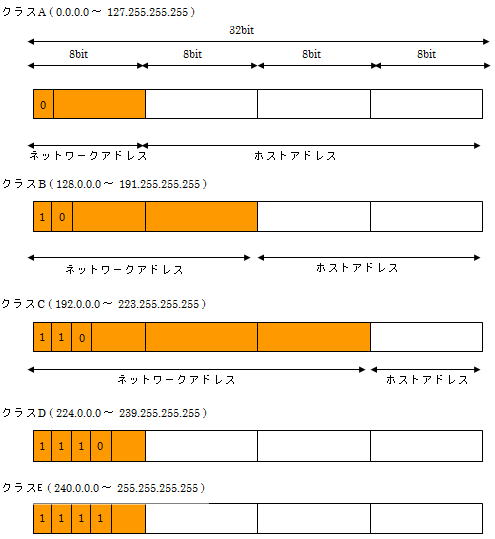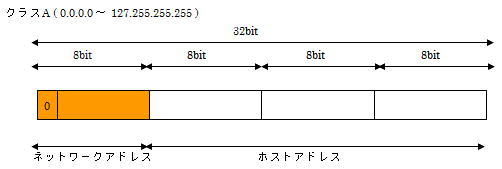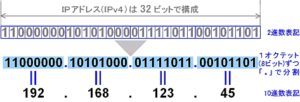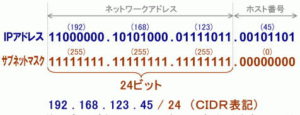IP Address Class Concepts
The concept of IP address classes
IP addresses have a classification method called address class. The concept of address classes has faded due to subnets and CIDRs, but it is an important concept that must be considered when designing a network.
*CIDR・・・An abbreviation for “Classless Inter-Domain Routing”. CIDR is a technology for assigning IP addresses and summarizing routes without using the concept of classes.
It is the bit pattern of the highest part of the IP address and is classified into five classes from class A to class E.

class A
Class A IP address ranges are as follows:
Class A ( 0.0.0.0 to 127.255.255.255 )
The first 8 bits are the network address and the remaining 24 bits are the host address.
However, the first 1 bit of the network address is determined to be “0” for identification purposes.
In other words, the first octet is a binary number ranging from “00000000” to “01111111”.
Converting to decimal number, it becomes “0.XXX” to “127.XXX”, 128 network addresses and 16,777,216 host addresses are reserved for each network address.
* “x” indicates the host address.
Class A will be the class class for the largest networks.
Class A addresses occupy half of the total IP address space (≈ 4.3 billion).
*The number of IP addresses explained here includes reserved IP addresses.

The default subnet mask value will be “255.0.0.0”.
class B
The range of Class B IP addresses is as follows:
Class B ( 128.0.0.0 to 191.255.255.255 )
The first 16 bits are the network address and the remaining 16 bits are the host address. However, the first two bits of the network address are determined to be “10” for identification purposes.
In other words, the 1st and 2nd octets are binary numbers ranging from “10000000.00000000” to “10111111.11111111”.
When converted to decimal, it becomes “128.0.XX” to “191.255.XX”, with 16,384 network addresses and 65,536 host addresses for each network address.
* “x” indicates the host address.
Class B is the second largest address class after Class A.
*Because the first two bits of the network address are fixed.
2 14 = 16,384.
Class B addresses occupy 1/4 of the total IP address space (≈ 4.3 billion).
*The number of IP addresses explained here includes reserved IP addresses.

The default subnet mask value will be “255.255.0.0”.
class C
Class A IP address ranges are as follows:
Class C ( 192.0.0.0 to 223.255.255.255 )
The first 24 bits are the network address and the remaining 8 bits are the host address.
However, the first 3 bits of the network address are determined to be “110” for identification purposes.
That is, the 1st, 2nd, and 3rd octets range in binary from “11000000.00000000.00000000” to “11011111.11111111.11111111”.
When converted to decimal, it becomes “192.0.0.X” to “223.255.255.X”, with 2,097,152 network addresses and 256 host addresses for each network address.
* “x” indicates the host address.
Class C is an address class for small networks.
Class A addresses occupy 1/8 of the total IP address space (≈ 4.3 billion).
*The number of IP addresses explained here includes reserved IP addresses.

The default subnet mask value will be “255.255.255.0”.
class D
The range of Class D IP addresses is as follows:
Class D ( 224.0.0.0 to 239.255.255.255 )
Class D is a special class that does not fall under any of the address classes from Class A to Class C.
In class D, the first 4 bits are determined to be “1110” for identification.
The intended use of Class D is for IP multicast. There is no host address part.
When expressed in decimal, the range is “224.0.0.0” to “239.255.255.255”.
Multicast communication is used, for example, by multimedia applications to broadcast audio or video data all at once. It is also used when routing protocols exchange route information with each other and is used in redundancy protocols.

class E
The range of Class E IP addresses is as follows:
Class E ( 240.0.0.0 to 255.255.255.255 )
In class E, the first 4 bits are determined to be “1111” for identification.
Class E IP addresses range from 240.0.0.0 to 255.255.255.255, and this class has been reserved for experimental use since the beginning of TCP/IP (IPv4) development. It is never actually used.

Reserved IP address
IP addresses range from class A to class E.
- Class A (0.0.0.0 to 127.255.255.255)
- Class B (128.0.0.0 to 191.255.255.255)
- Class C (192.0.0.0 to 223.255.255.255)
- Class D (224.0.0.0 to 239.255.255)
- Class D (224.0.0.0 to 239.255.255) E ( 240.0.0.0 to 255.255.255.255 )
Among them, addresses that can be assigned to network terminals are addresses from class A to class C. Class D is reserved for multicast and class E is reserved for experimental use.
Then, is it okay to use all the values among the addresses of class A to class C?
The answer is NO.
There are reserved addresses that have not been approved for general use in advance for special uses.
Class A reserves the first 0 and 127 of the network addresses (0-127). “127.0.0.1” is a virtual IP address that indicates itself, called a local loopback address.
Also, in the host address, all binary 0’s and all 1’s are reserved. I’m here.
In class A, private IP addresses from 10.0.0.0 to 10.255.255.255 are reserved.
The private IP address is as shown in the table below.
| class | explanation |
| class A | 10.0.0.0 to 10.255.255.255/8 |
| class B | 172.16.0.0 to 172.31.255.255/12 |
| class C | 192.168.0.0 to 192.168.255.255/16 |
For example, in class A, the following addresses are reserved and cannot be used.
| “0.0.0.0” | network address reserved, host address 0 |
| “127.0.0.0” | network address reserved, host address 0 |
| ‘127.10.10.87’ | network address reserved |
| “20.0.0.0” | Host address is all “0” |
| ‘42.255.255.255’ | All host addresses are “1” |
There are also reserved addresses for class B and class C as well. For both Class B and Class C, private IP addresses and host addresses that are all binary “0” and “1” cannot be used.


